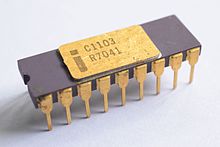
Summary
The 1103 is a dynamic random-access memory (DRAM) integrated circuit (IC) developed and fabricated by Intel. Introduced in October 1970, the 1103 was the first commercially available DRAM IC; and due to its small physical size and low price relative to magnetic-core memory, it replaced the latter in many applications.[6][1] When it was introduced in 1970, initial production yields were poor, and it was not until the fifth stepping of the production masks that it became available in large quantities during 1971. Intel shipped the 250,000th 1103 RAM at June 1974.[7]
 A ceramic C1103 variant. | |
| Media type | 8 μm p-MOS DRAM |
|---|---|
| Capacity | 1 kilobit |
| Standard | 18-pin DIP |
| Developed by | Intel |
| Usage | HP 9800 series,[1] PDP-11,[2] MAXC[3] and others |
| Released | October 1970[4] |
| Discontinued | 1979[5] |
Development edit
In 1969 William Regitz and his colleagues at Honeywell invented a three-transistor dynamic memory cell and began to canvass the semiconductor industry for a producer. The recently founded Intel Corporation responded and developed two very similar 1024-bit chips, the 1102 and 1103, under the lead of Joel Karp, working closely with William Regitz.[8] Ultimately only the 1103 went into production.
Microsystems International became the first second source for the 1103 in 1971.[9] Later National Semiconductor, Signetics, and Synertek manufactured the 1103 as well.
Technical details edit
| tRWC | 580 ns | Random read or write cycle time (from one +ve Precharge edge to the next) |
| tPO | 300 ns | Access time: Precharge High to valid data out |
| tREF | 2 ms | Refresh time |
| VCC | 16 V | Supply voltage |
| p-MOS | 8 μm[10] | Production process (silicon gate MOSFET) |
| Capacity | 1024x1 | Capacity x bus width |
References edit
- ^ a b Mary Bellis (August 25, 2016). "Who Invented the Intel 1103 DRAM Chip". ThoughtCo.
- ^ PDP-11/45, 11/50, and 11/55 System Maintenance Manual (PDF). Digital Equipment Corporation. September 1976.
- ^ Fiala, Edward R. (May 1978). "The Maxc Systems" (PDF). GitHub. IEEE Computer Society. Retrieved October 12, 2022.
The most significant contributor to reliability has been main-memory error correction. During the first six months of operation, we replaced about 12 failing 1Kx1 MOS RAMs per month (out of a population of 18,432 chips): this has gradually declined to about three failures a month during the last three years. However, because of error correction, a negligible number of these failures has caused crashes.
- ^ "Defining Intel: 25 Years/25 Events" (PDF). Intel Corporation. Page 6.
- ^ Intel Corporation, "The 1103 retires!", Intel Preview, March/April 1979, page 23
- ^ Jacob, Bruce et al. (2008). Memory Systems: Cache, DRAM, Disk. Morgan Kaufmann Publishers. pp. 457–458.
- ^ A Milestone for the 1103
- ^ Computer History Museum: "Oral History of Joel Karp" Interviewed by Gardner Hendrie March 3, 2003 | Atherton, California
- ^ Tedlow, Richard S. (2006). Andy Grove: The Life and Times of an American. Portfolio. pp. 141–142. ISBN 9781591841395.
- ^ Lojek, Bo (2007). History of Semiconductor Engineering. Springer Science & Business Media. pp. 362–363. ISBN 9783540342588.
The i1103 was manufactured on a 6-mask silicon-gate P-MOS process with 8 μm minimum features. The resulting product had a 2,400 μm2 memory cell size, a die size just under 10 mm2, and sold for around $21.


